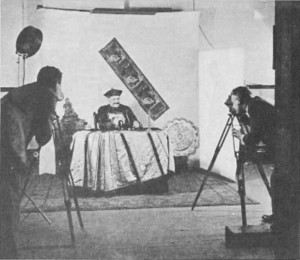
"In The Barrier, Glen H. Turner, Maxim Award winner in 1949 with One Summer Day, shows that the excellence of that production was no happy accident. Although the two films are as different as night and day, both are instinct with the same qualities of creative imagination and true understanding of the movie medium. This year's production, as we understand it, is bi-lingual in its message. On the screen Mr. Turner tells a robust adventure tale, in which a wandering western horseman, attacked by unfriendly Indians, has to fight his way out of their clutches and (even more menacing) over the heart-stopping challenge of a great stone barrier to his freedom. Around this screen action, and carried by the narrative, the producer also draws a frame of universal reference to all of life's challenging struggles. Pictorially, the acting of the horseman is powerful and convincing, while Turner's camera treatment of his adventures creates a spine-chilling sense of danger and drama. Especially effective is the producer's handling of the Indians, whose menacing presence is suggested only — by moving shadows, braceleted brown arms or moccasined stealthy feet." Movie Makers, Dec. 1950, 466.

Promotes the all-round activities of YMCA work and their relationship to character-building. Kenyon, a one-time YMCA athlete, has "fallen into evil companionship" and become addicted to cocaine. Under the control of Chinese underworld kingpin Chang Yat, he aids in the kidnapping of a white girl. Afterwards, he discovers his old "Y" pin and recalls the role of YMCA athletics in shaping his character. Seized with remorse, he overpowers Chang Yat and helps the girl escape. Later, Kenyon returns to the YMCA. (D.J. Duffy, condensed from "Y.M.C.A. Cinema Club Produces Smart Film," Toronto Daily Star, May 31, 1930, p. 30.)
Film was sponsored or co-produced by the Central Y.M.C.A. of Toronto, and written by the club's secretary, H.G. McKinley.

"An amateur film made by and starring the husband and wife duo, John & Evelyn Kibar. Title cards with dialogue are dispersed throughout the film." Chicago Film Archives

"An English satire on army life at an outpost, by the Grasshopper Group, is a clever bit of cartoon work in color. There are soldiers and officers to line them up for drill and a mischievous little girl to upset the decorum. The enemy has charged, the battle is on, with the silly antics of a comic. Finally, the enemy is defeated and rolled up in a caricature polo fashion. A delightful cartoon, interesting and entertaining." PSA Journal, Nov. 1957, 32.
"Dramatic short of a frumpy woman's dream of the alternate course her life might take were she a beauty." oldfilm.org

"Beach Holiday, an 8mm. story in Kodachrome, deserves high praise because of its smooth and interesting treatment of material that is directly within the reach of every movie maker. Made by Raymond O'Connell, this subject is a fine example of natural continuity, done in a simple, straightforward manner. The interior shots, which show the family getting up in the morning, their planning and preparation for a day at the beach and, at the end of the film, their return home, afford excellent examples of good exposure and technical work on 8mm. interior scenes. Many of the transitions are well planned, notably a clever shot which shows the final packing of the picnic hamper at home. Its cover is raised in the kitchen, so that the hamper fills the entire frame. The cover is then lowered, revealing a beach scene in the background. The outdoor work gives an excellent exposition of a day at the beach, complete with swimming, sports and boardwalk amusements." Movie Makers, Dec. 1937, 628.
"The Beasts Shall Inherit the Earth for the excellently made props in the form of creatures that appear in the film from time to time to drive out the populace and take over for themselves. Many times these props look genuinely alive" PSA Journal, Sept. 1966, 36.
"Because I Say So is a club production and concerns the influence a certain "Count Polo" has on women. His latest book "Woman Perfected" advises women how to be better wives. At least one woman tries his theories - and the climax of the picture proves Count Polo knows what he is talking about - or does he?" PSA Journal, Sept. 1964, 50.
Total Pages: 299